"What's wrong with my citrus tree?"
This possibly the most frequently asked question that I come across!
Usually, a grower has had the unfortunate experience of all of the leaves, flowers and fruit suddenly falling to the ground.
This sudden drop of fruit, leaves or flowers is a sign of a stressed citrus tree.
Stress for a citrus tree can be any of the following:
- Not enough water
- Too much water
- Not enough fertiliser
- Too much fertiliser
- Too hot
- Too cold
- Too windy
As you can see, there are many conditions that are stressful to a citrus tree. It can be challenging, if not impossible to diagnose the underlying issue, without seeing the citrus tree in person. Providing consistent, favourable conditions for your citrus tree, will be the key to growing masses of tasty citrus fruit.
Pests and diseases of citrus
There are several common pests and diseases that affect citrus trees in Melbourne. Generally pests only attack weaker trees. By planting your tree in a suitable location and providing the right fertilising and watering regimes, your tree will stay healthy and strong.
Aphids
Aphids can infest new growth, mainly in spring. They are sap feeders and secrete sticky honeydew. The harmless fungus black sooty mould, often grows on this honeydew. Winged aphids are carried by wind to infest other trees and can carry the tristeza virus. Ladybirds, hoverflies and lacewings all feed on aphids. Avoid spraying small populations of aphids early in the season. Their natural predators will multiply and eventually control them.
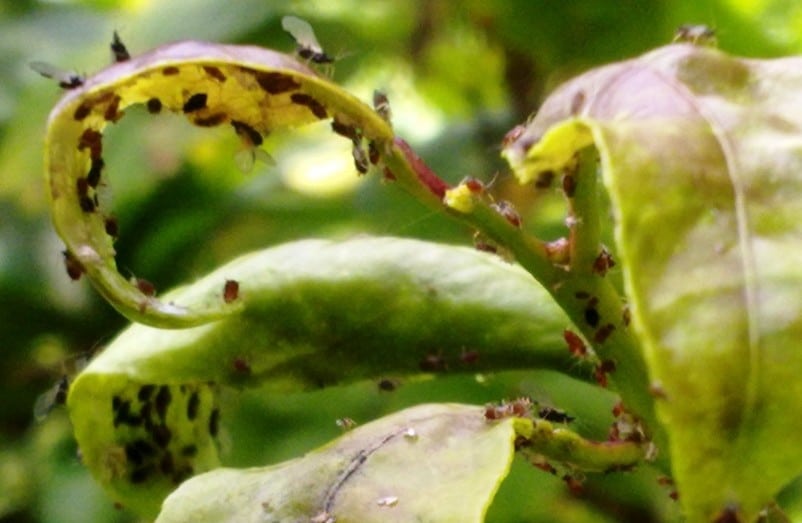
Mature trees can sustain heavy infestations without damage. Aphids can be hosed off with a jet of water, wiped off with your fingers or sprayed with white oil.
Scale
Adult scale insects are mostly immobile on the plant.
They feed by withdrawing sap through their sucking mouth parts. Juveniles emerge at various times of the year and spread to other plants by wind, birds, insects and on our clothing.
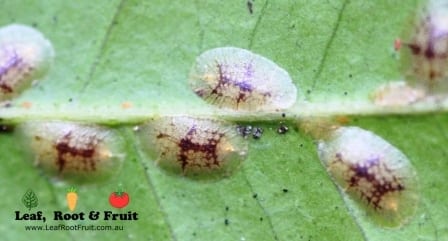
Some of the scales (eg Soft scales) produce honeydew on which black sooty mould may grow. These scale are often protected from predators by ants.
Small infestations of scale are not normally a problem for citrus trees. Larger numbers can be scraped off with your finger, or sprayed with a white oil solution. Controlling ants is another way to keep scale in check.
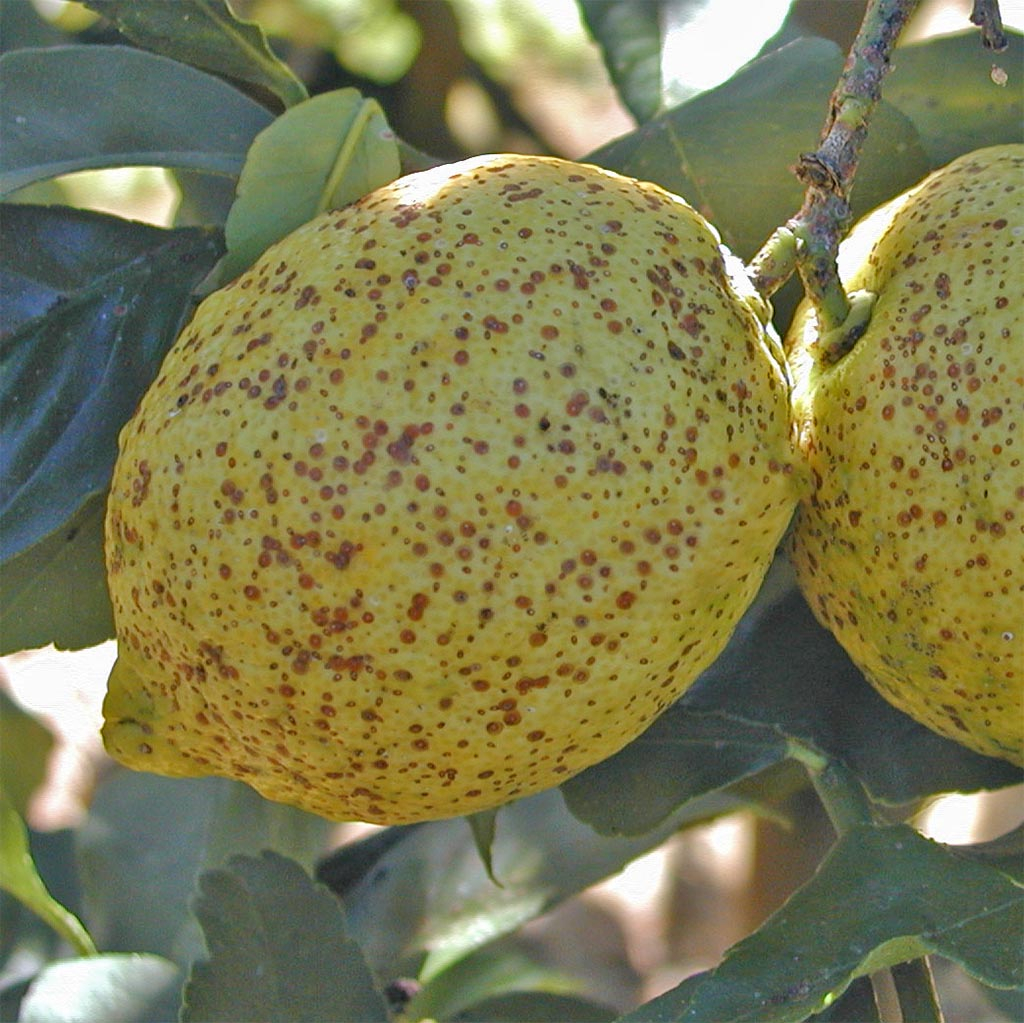
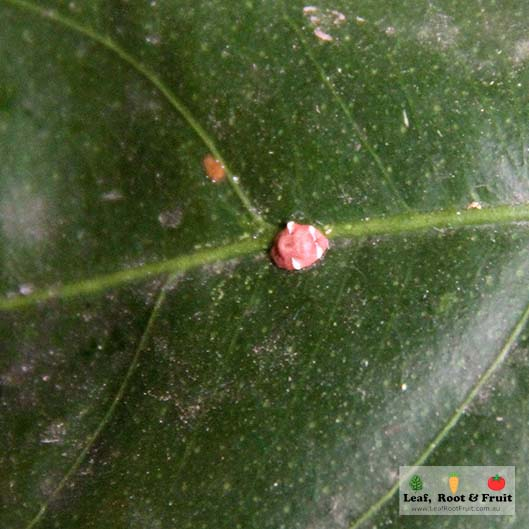
Treat the underlying cause to prevent scale in citrus trees
You can reach for the white oil, to kill the scale. My approach to controlling scale is to treat the underlying root cause. I have noticed that scale tend to present on trees that are struggling to obtain the nutrients that they need to grow strong and healthy. An underfed tree tends to attract scale. There are many different ways to top up soil nutrients for your citrus tree. A handful of general purpose organic fertiliser will usually do the trick. It will also help the tree to be more productive. In our citrus gall wasp experiment we found that fertilising regimes had a huge influence in the productivity of the trees.
Citrus Gall Wasp
The presence of large swellings or bulges on the branches of citrus trees is quite common in Melbourne.
These swellings indicate that Citrus Gall Wasp has infected the tree.
This tiny native Australian wasp lives for 3 to 4 days laying its eggs in the branches of the citrus tree. It is the tree’s ‘reaction’ to this egg-laying which produces the next year’s Citus Gall Wasp.
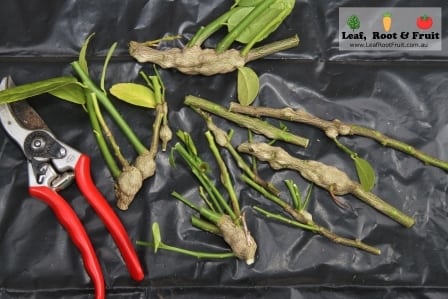
The traditional way to control of Citrus Gall Wasp is cutting off the swollen branches in winter. I believe that this approach exacerbates the problem. It also has a negative impact on many citrus around Melbourne. Take a look at our gall wasp blog post for some alternative control methods to pruning out the galls.
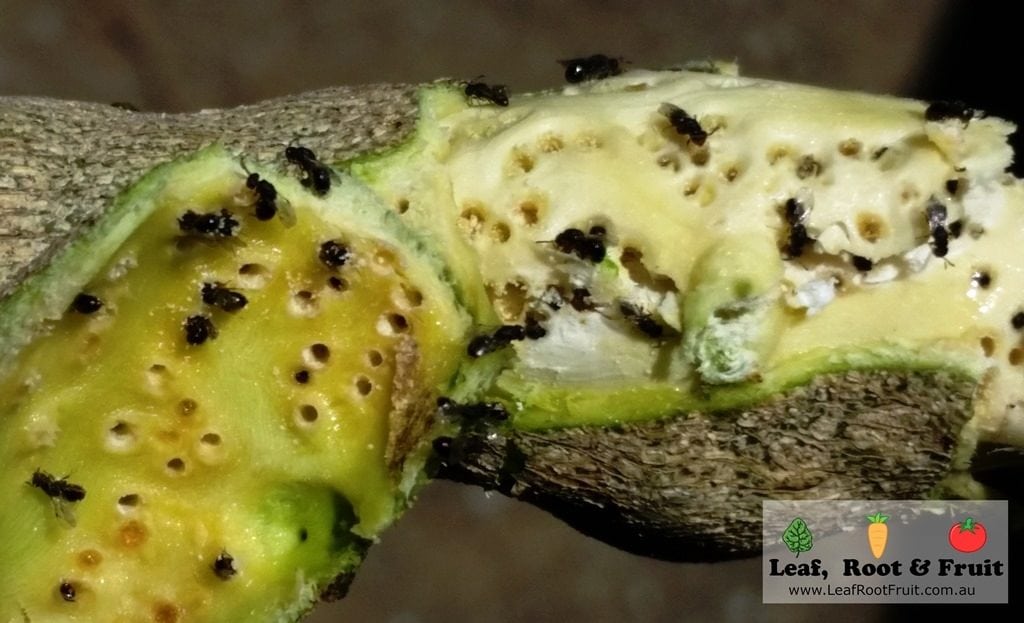
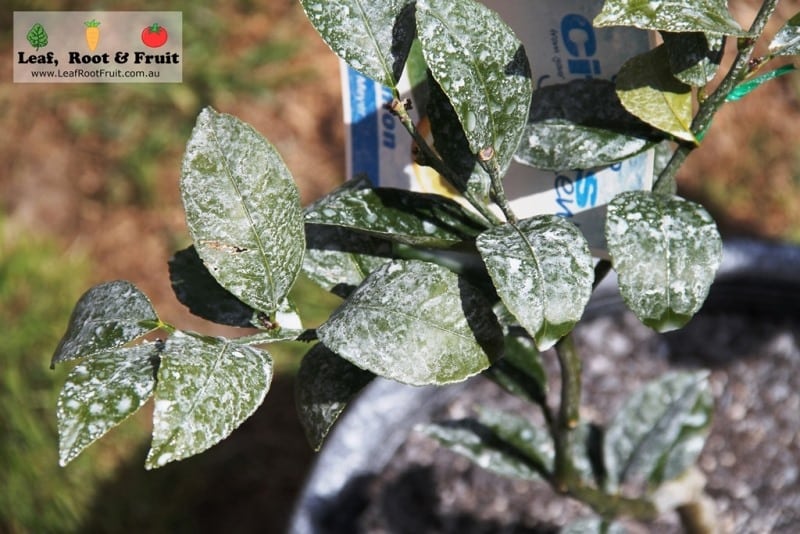
Citrus Leafminer
Citrus leafminer is the larva of a tiny silvery white moth about 2mm long, when at rest. Adult moths are active at night so are rarely seen. The tiny larvae tunnel in immature leaves when they feed and leave wavy silvery trails. Leaves become crinkled, distorted and curl up at the edges when the larvae form their pupae.
Young trees are particularly susceptible and heavy infestations can severely stunt their growth. However, large, established trees don’t usually show any long terms affects from this pest.
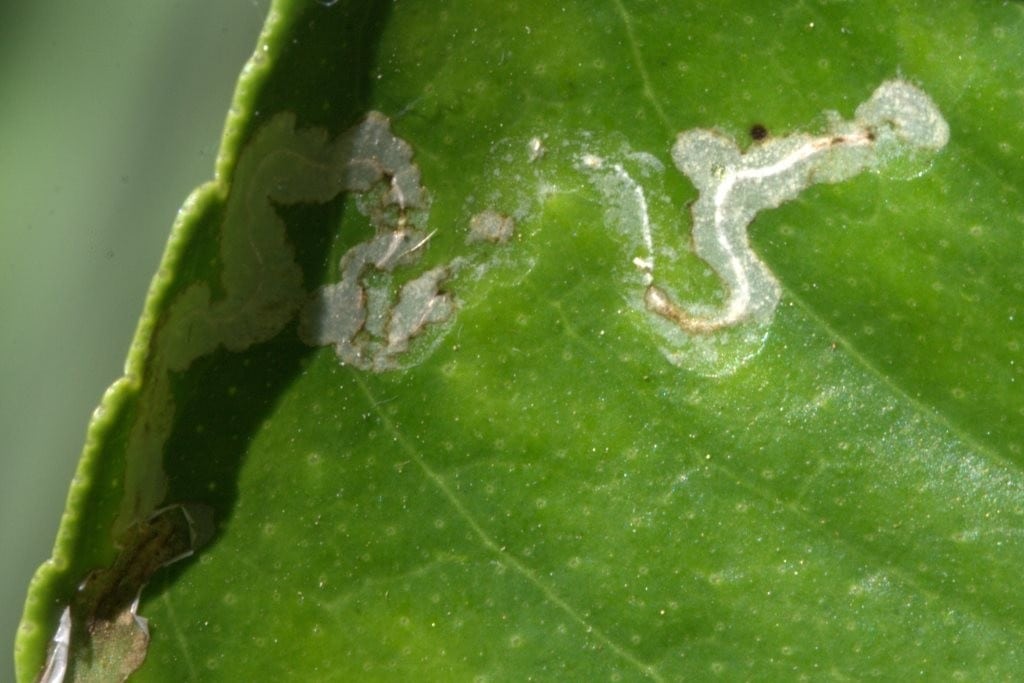
The affected foliage looks unsightly, but doesn’t impact the tree that much. I don’t bother to do anything about it. Significant infestations occur mainly on new growth in late summer and autumn.
Control of citrus leafminer is difficult. Because the leafminer is inside the leaf, sprays are generally ineffective. Affected growth, can be continuously removed to interrupt the life-cycle. Avoid fertilizer high in nitrogen, after February, to stop promoting new growth at this time.
Phytophthora (Root Rot)
Phytophthora is the most common fungus to cause root rots in citrus. It grows on susceptible rootstocks in conditions where trees and soil remain wet for long periods. The bark near ground level becomes soft, dark-stained, water-soaked and sometimes gummy. The wood beneath the bark turns dark brown and dead bark is sometimes shed in vertical strips. Severe infection of the trunk and main roots, will kill the tree.
There is no treatment for this disease. To prevent phytophthora, only grow trees grafted onto Trifoliata (or Flying Dragon) rootstocks in Melbourne (see Part One for more information on this). Select well-drained sites avoid mulching too closely to the trunk and avoid over-watering the tree.
Common Citrus Problems
There are several other “issues” that you might notice when growing citrus in Melbourne.
Graft incompatibility
Some citrus trees grown on Trifoliata rootstocks suffer from incompatibilities. For example, Imperial Mandarin has an incompatibility with Trifoliata rootstock. This causes abnormal growth at the graft union. The tree will likely die from this incompatibility at around just fifteen years post grafting. Check out my guide to fruit tree rootstocks for more information on this.
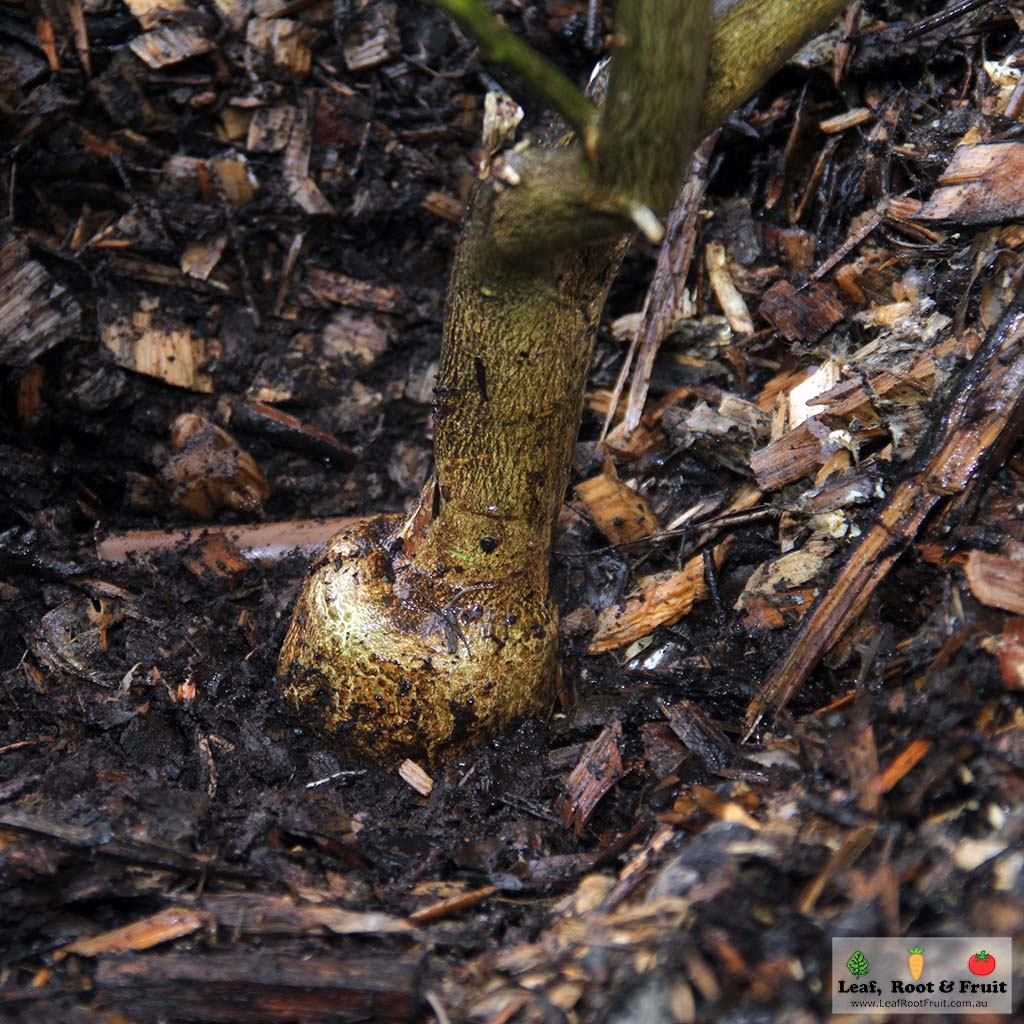
Summer fruit drop
Citrus normally shed large numbers of fruitlets shortly after blossoming in the spring and at early fruit set (pea size). However, it is also common for a sudden drop of small fruit (20 mm diameter) to take place in the summer, when warmer weather places stress on the tree. The problem is particularly severe in young navel orange trees and may be related to lack of water at, or soon after, fruit set. Root diseases and lack of nitrogen or trace elements may also be responsible.
Rind splitting
Rind splitting of fruit, particularly in navels, also occurs before or near maturity as a result of climatic factors. These factors specifically are drops in average temperatures and increases in relative humidity, at a time when the rate of fruit growth is decreasing. There is no control for the disorder.
Frost damaged citrus fruit
We have many citrus trees thriving in a protected spot of our property. The frosts in Kyneton are quite severe, but more of the trees cope with it well. However, the exposed fruit of the Tahitian lime often shows frost damage or frost burn. The damaged fruit is still fine to consume but the shelf life is reduced.
Our lime tree is very productive. When the heavy frost damages lots of fruit we get busy making lime cordial.
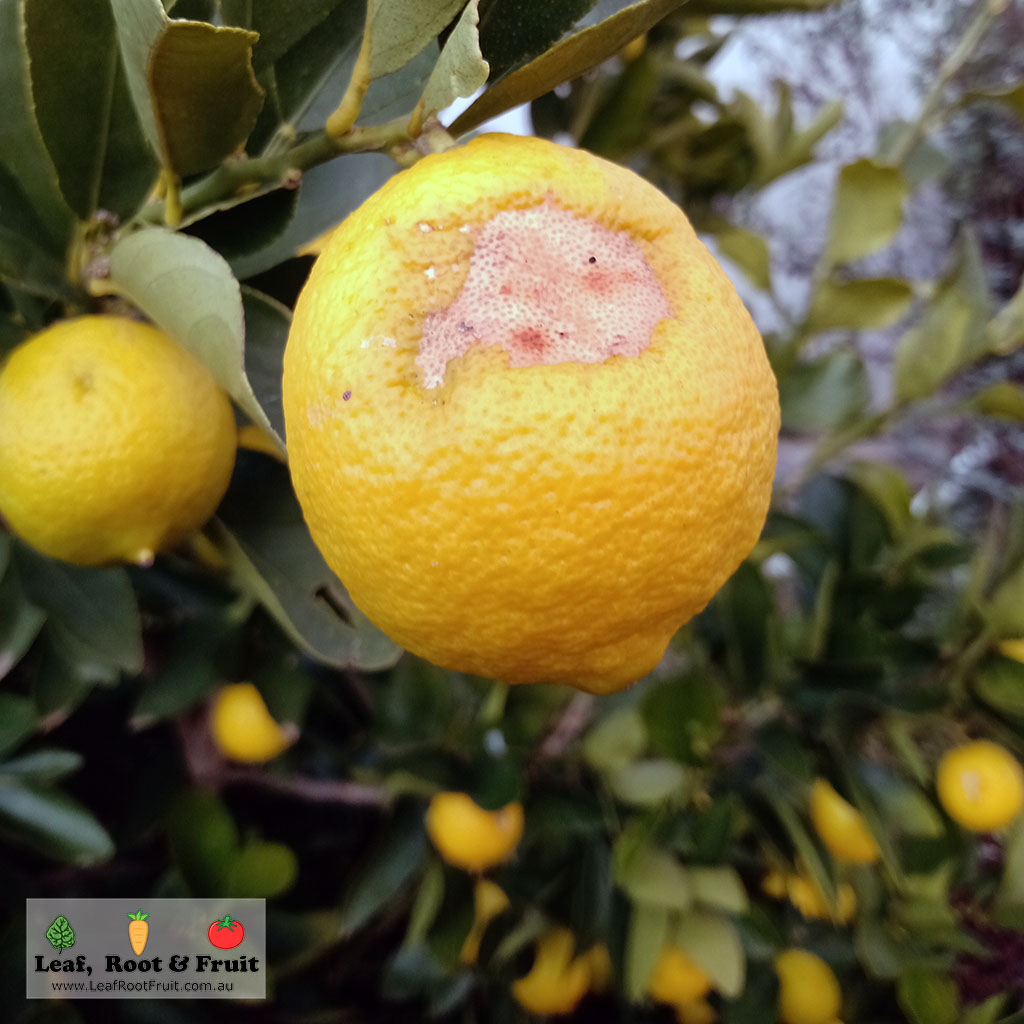
Preharvest drop
Preharvest drop in the autumn, before fruit is fully mature, is a common problem with navels and grapefruit. Some of this drop is natural. Some mandarin and lemon varieties, will also shed fruit when damaged by the spined citrus bug. Brown spot infection in mandarins will result in fruit drop.
Alternate cropping (biennial bearing)
Alternate cropping (biennial bearing) is a common problem with many citrus varieties, such as Valencia orange, Wheeny grapefruit, and mandarins. After a heavy crop the tree often responds by carrying a light (or nil) crop. Once this cropping pattern is established it is difficult to return to regular annual cropping. Pruning or thinning of the heavy crop, and early harvesting will assist in reducing the problem.
Second crop fruit
Sometimes, orange trees will produce blossoms in the autumn after a stress period, and set a second crop. This fruit is often of poor quality (thick skins and low juice content). With lemon trees, however, these intermediate crops are desirable as the fruit quality remains high.
Want to know more about Growing Citrus in Melbourne?
This is Part 5 of a 5 part guide to growing citrus in Melbourne. The links below will take you to the other four parts of my Melbourne citrus growing guide.
Citrus Growing Guide Part 1: Citrus Varieties for Melbourne
Citrus Growing Guide Part 2: Where and How to Plant Your Citrus Tree
Citrus Growing Guide Part 3: Ongoing Care and Management of Citrus Trees
Citrus Growing Guide Part 4: Pruning and Shaping of Citrus Trees
My citrus growing guides are based on my own experience, as well as the following books. They are all invaluable resources for the home gardener based in Melbourne. I strongly recommend you have a read of them, if you want to know more about growing citrus in Melbourne:
Ian Tolley: Commonsense Citrus, 2017
Bruce Mophett & Ian Tolley: Citrus, A Gardener’s Guide, 2009.
Louis Glowinski: The Complete Book of Fruit Growing in Australia, 1997.


Hi, thanks for the useful tips.
Just have a question.
My lemonade lemon tree never fruits I’ve had it for a few years now and havnt received any lemons.
Any tips would be greatly appreciated.
Thanks again.
Hi Nathan,
That could be all manner of issues (so many that it took a 5-part blog to cover them all!). It could be anything to do with fertilizing, watering, position, soil, issues with wrong root stock, or root stock taking over or a combination of above. Without seeing the tree and knowing more about it, I wouldn’t like to guess. Lemonade trees are generally reliable producers.
If you’ve read through our 5 part guide and think you’ve covered everything in there, then feel free to email me some more info, including a few photos and I can try and offer more advice. Otherwise a site visit might be required to diagnose the issue.
Good Luck and Happy Gardening!
Duncan
Hi. I ha be a lovely lemon tree been in for over 10 yrs. produces lots of fruit. However this yr every lemon I cut open has brown streaks through it. Haven’t had this problem before. Could it be that we have had a fairly wet autumn & so far winter in Victoria
I think you are spot on their Julie. The humid, wet spring is leading to all sorts of fungal issues.
Hopefully next year will bring better citrus and stone fruit crops.
Thankyou!
Sad I’ll have to wait a whole year, but at last reading your excellent article I know what to do.
Jenny Stanley
Hi Jenny,
Glad you found our guide useful. Good Luck!
Duncan
Thank you very much for this useful information.
I am in the Yarra Valley and fruit fly has now entered this region. Nearly all my oranges and lemons (together with my tomatoes and peaches,) have been badly affected. I’ve put traps, lures and nets but all have been ineffective, especially given my neighbours don’t do anything to prevent them.
Any ideas of what else I could try?
Thanks,
Heidi
Hi Heidi,
I’m sorry to read this. It must be so frustrating. Good hygiene is critical. The number one rule of QLD Fruit Fly is prevent any piece of fruit from hitting the ground. This is the best way to break the life cycle. Although, if your neighbours are not being proactive then it will be challenging to control. Netting the trees early in the season will be critical for success in future years.
Good Luck & Happy Gardening
Duncan
Thank you for the useful information,
I’m a gardener and have seen many sitrus trees with gall wasp I was cutting the brunches but I didn’t know the name to tell my costumers ,
Thanks again
Shay
A man with a plan
Thanks for the feedback Shay
Good Luck and Happy Gardening!
Duncan
Citrus Gall Wasp BUT do they hurt the tree I just pruned a lime tree ,took 1/4 of the tree that was loaded with limes irrespective of the swollen branched, it had a very bad infestation
They seem to effect my lemon tree too , BUT NOT THE BLOOD ORANGE
Hi Louis, thanks for sharing. Yes, the Citrus Gall seem to prefer lemon and lime trees over orange trees. I’m trialling a few different “regimes” for coping with the gall wasp. It’s a complex topic and one worthy of a blog post in its own right. I’ll put it together once I’ve confirmed my preferred regime for dealing with the gall wasp.
Stay tuned!
Duncan
Hi, my 30 year old, grafted lemonade tree, appears to be getting something similar to blackspot on the fruit skins?, and more noticeable every year for the past 3 or 4. The fruit is still delicious.
I live in the bayside area of Melbourne, grow it organically with straw mulch, water is sufficient unless high summer. Open foliage to get air flow etc etc.
I have been reading things on the internet, but its all commercial stuff (USA), nothing organic etc.
Have you any ideas?
Hi Gill,
Sounds like citrus black spot. This is caused by a fungus and once the tree has been infected, it has it for life. You can reduce the severity of the symptoms by reducing the fugal spores in the soil (through using god quality compost) and increasing air flow around the tree. You could use a copper fungicide, of which there are a few organic options avaiable, but they are still only going to treat the symptoms rather than provide a cure. Once the tree starts getting overwhelmed by the disease, it is best removed. Keep in mind that any other citrus trees that you plant in the spot in future are also likely to get infected.
Good Luck and Happy Gardening!
Duncan
some of the fruit on my citrus are having the skin completely eaten away with just the flesh of the whole fruit left, hanging on the tree. I am wondering what is eating the skin. I have wondered if it is possums or rats or even bats. Do you have any idea?
You give good information and I enjoy your emails. Thank you
Hi Janine,
Thanks for the great feedback. In my experience that’s usually rats causing the problem. Some folks have reported that possums also do this, but I have not seen it myself.
Good Luck & Happy Gardening!
Duncan
Thank you Duncan, I appreciate your reply and since writing and reading your reply I have seen a rat at the bottom of the garden
Hi Gill,
Sounds like citrus black spot. This is caused by a fungus and once the tree has been infected, it has it for life. You can reduce the severity of the symptoms by reducing the fugal spores in the soil (through using god quality compost) and increasing air flow around the tree. You could use a copper fungicide, of which there are a few organic options available, but they are still only going to treat the symptoms rather than provide a cure. Once the tree starts getting overwhelmed by the disease, it is best removed. Keep in mind that any other citrus trees that you plant in the spot in future are also likely to get infected.
Good Luck and Happy Gardening!
Duncan
My line tree 10 years old and friuiting well issuddenly being branches dying after something is eating many outside bark from branches to reveal the inner white. It must happen at night?
What is it ? I am in Rye Victoria….claire Spr
Hi Claire,
without seeing the damage it can be hard to tell. But my guess would be rats are eating the bark. Possibly possums, but most likely rats.
It might be worth heading out with a torch in the evening to see if you can spot the culprit!
Good Luck and Happy Gardening!
Duncan
I have Oleanders growing near my citrus trees and I am constantly fighting leaf miners, are they related? Is the Oleander a cohost?
Hi John,
I’m not aware of Oleander acting as a cohost, although it may be possible. I find the best way to avoid leaf miner is to just avoid fertilizing after early Feb. Hopefully someone from our growing community has some ideas on the oleander for you!
Please keep us updated.
Duncan
HI guys and ladies,
I wonder if you can help me please.
I have inherited from our daughter two citrus trees ( blood oranges ) about 50 cms high in pots that as a result of neglect have lost their leader stem . The top part has died off.
Is a new leader stem able to be encouraged to grow to enable the plant to continue to full height or can it only remain as is.
Regards,
Victor Boaro
Perth
Hi Victor,
Thanks for your inquiry. Without seeing the trees, it’s a bit difficult to say. Assuming the trees are grafted, you’d need to be sure that some of the scion was still alive to re-shoot. Otherwise, you may just be encouraging the rootstock to regrow, which won’t produce blood oranges!
Good Luck and Happy Gardening!
Duncan
Thank you Duncan.
Kind regards
Victor
Hi
I recently planted lotsa lemons. The plant is looking very healthy with lots of flowers and small lemons starting to form. However, in the last week or so something is eating the leaves, particularly the lower branches. Apart from seeing some ants around I am unable to I find the culprits. No sign of snails but I did see one earwig but I don’t know if that’s the problem.
Many thanks in advance.
Hi Lidija,
Without seeing the tree it can be hard to say. However, my guess would be earwigs. It’s certainly the season for them to be doing damage. They are nocturnal, so the best way to tell is to head out at night with a torch and see if they are having their nightly feast.
If it does turn out to be an earwig problem, post on controlling earwigs may be useful for you.
Good Luck and Happy Gardening!
Duncan
i am finding what look like bite or peck marks in my myer lemon fruit and separately from that, caterpillars ,browny/orange in colour, about 3 cm long.fruit with damaged rind seems to be o.k to use and so far hasnt deteriorated . could this be snails? the caterpillar problem has not occurred before ,tree is approx 13 yrs old ,with fruitfly traps in it. can you advise? regards , ross
Hi Ross,
without seeing the fruit it’s difficult for me to say. Does the damage look like a mechanical injury (ie something biting it) or is it more like brown or coloured “pocks” that could be caused by fungal issues?
As for the caterpillars, you can either pick them off by hand, spray with dipel, or just wait for the predatory wasps to turn up and kill them off (I’d choose option three!). Planting plenty o flowering plants in your garden will encourage beneficial insects such as predatory wasps into the garden. This will support a healthy ecosystem and reduce the severity and impact of pest populations.
Good Luck with the Lemon Tree!
Duncan
Looking for what moth, or what this bug and leaf damage is on this Melbourne Lemon plant. Thank you!
https://plus.google.com/u/0/+DerekWhitten/posts/MMrp8pzdUdR?cfem=1
It looks like a moth of sorts, the leaf damage looks like a catepillar. Can anyone name this moth and tell me if it is dangerous and how to eradicate it if so? Thanks again.
It’s a Passionvine hopper. Which is a sap sucker rather than a leaf chewer. So I don’t think it is what is causing damage to the leaves. It could be earwigs, or mechanical damage such as wind damage. I’d be inclined to just leave nature to sort it all out for you.
Good Luck and Happy Gardening!
Duncan
Hi.
We have three espalier citrus trees that are in a sheltered position ( little direct sunlight ). Melbourne. The lime has upper leaves that have a brown area and some leaf area missing. Leaf is also a little curled but not as much as ” Leaf Curl “. Back of leaf has shiny silver areas ( look like a clear plastic film ). Any idea what this is ?
Hi Allen,
It is likely to be Citrus Leaf Miner, which is prevalent in autumn. Treatment is very difficult. Prevention is best achieved by not fertilizing in late summer or autumn. It’s not overly detrimental to the tree anyway. Just remove the affected growth if you find it unsightly.
Good Luck and Happy Gardening!
Duncan
Hi LRF, great website! I’m wondering whether I should keep my desert lime. I have had it ten years and never got any fruit, and rarely flowers. It is planted on a mound of mulch under a callistemon against a north-facing fence, and gets intermittent sunlight all year. I don’t water it regularly. At some point it suffered severe damage to one half of the trunk, but I am sure the root stock did not take over. I have heard these plants need another tree to assist with pollination: is this true?
Hi Joanne,
Thanks for the great feedback. Sounds like your desert lime is being out-competed by the callistemon. The larger tree is likely to be utilising all the nutrients and water, leaving nothing for the desert lime. I’d consider moving it to another part of the garden and ensuring it gets plenty of water and nutrients. Then you should find that it flowers more regularly and may produce some fruit.
Good Luck & Happy Gardening!
Duncan
I have a problem with my citrus trees and need someone who knows how to diagnose the problem and advise me how to prevent them from getting worst or die. I alreadt have lost one of my beautiful orange tree. I will be most grateful if you can advise me who can I get to come to see the trees and advise me what to do.
Thanking you in anticipation.
Hi Olga,
We offer on-site consultations. During the consult we could look at your tree, diagnose the issue and recommend strategies to deal with it. You can book in via this page on our website
Good Luck and Happy Gardening!
Duncan
Good Luck and Happy Gardening.
Have had very nice grapefruit in the past 4 years. Large, sweet and abundant. This year, fruit is small, thought you might tell me what the problem is. Continued to fertilize, water as usual
Hi Nancy, without seeing the tree it is difficult to say. Normally I would say a lack of water would be the problem. However you say this has been as per previous years. Perhaps there are more fruit on the tree than previous years?
I have an old mandarin tree in my yard which until last couple of years was thriving. In last couple of years it has almost died back more and more, to the point where this year there is very littlr foliage and it is all sickly and yellowish. It is still fruiting ok. There is also a growth of some sort around the base of the trunk, sort of like a wood version of blood pressure cuff in appearance, if that makes sense. Im assuming that it is that whic is causing all the issues. Any thoughts on what it is?
Hi Mina,
My guess is that it is an imperial mandarin tree. What you are describing is a common problem with this particular variety. It has a graft incompatibility with Trifoliata rootstock. As the tree ages, the rootstock grows much larger than the scion (trunk) of the tree. This creates a restriction at the graft union and without intervention the tree will die. The best prevention for this is to graft the tree using an interstock such as an orange. However trees such as this are not commercially available. Frustratingly it means most commercially available Imperial Mandarin trees in Melbourne have a lifespan of around 15 years.
The best method to fix the problem in existing trees to create some inarch grafts to bypass the graft union. Ian Tolley has a great description of this process in his book “Commonsense Citrus” on page 199.’
Best of luck with remedying the problem
Duncan
Hi, I have a potted lemon on my balcony, it has 2 Lemons on it from last year, but it is loaded with flowers, far too many for fruit, what should I do? Should I remove some of the flowers, if so which ones, I would be grateful for any advice.
Terry
Hi Terry,
Generally the tree will manage its fruit quantities ok and abort whatever it cannot manage. However, if there are lots of fruit, you may want to thin some when it gets to the size of a your thumbnail. This can help prevent biennial cropping.
Good Luck & Happy Gardening
Duncan
I have a dwarf Tangelo Seminole that was bought around May 2019 and flowered late 2019.
A few flowers developed in late 2020, and then the leaves, which were still green, fell off.
The trunk of the plant shows green patches and shoots continue from below the graft line.
Do you have any idea about what has happened to my plant and how I can restore it?
Hi Robin,
Citrus trees are fickle things! They tend to flower (and then abort) or loose their leaves when stressed. Stress for a citrus tree can be: too much water, not enough water, too much fertilizer, not enough fertilizer, too hot, too cold, too windy. If the trunk above the graft union is still living then the tree may come good. Just keep removing the root stock shoots. If only the root stock is alive, then it’s time for another tree unfortunately.
Good Luck & Happy Gardening
Duncan
My lemon tree is producing fruit with odd shaped, multiple finger like fruits. What might cause this and can this be treated?
Hi Max,
This is likely to be caused by citrus bud mites. If it is just a few affected fruit then I wouldn’t do much at all. If the tree is badly affected then some white oil should reduce the mite numbers.
Good Luck & Happy Gardening!
Duncan
I live in Melbourne, I have lime tree what I planted one year ago. It have been growing well but now end of the winter it has started dropping leaves. It looks healthy otherwise and does not seem dry or over watered. Not sure if the cold night are stressing it.. Would you have any advice?
Hi Elias,
Citrus trees drop their leaves as a sign of stress. Stress for them can be too much water, not enough water, too much nutrient, not enough nutrient, too cold, too hot, too windy. Without seeing the tree it is difficult for me to diagnose which cause of stress the tree is experiencing. Hopefully a bit of detective work will help you work it out and rectify.
Good Luck & Happy Gardening!
Duncan
I think the cause was cold weather. Now it has started to warm up in Melbourne and it have pushed more leaves and flowers.
Hi, Enjoying excellent articles but would have liked to have printed out this and some other articles but no luck. Can you fix with a print facility?
Thanks Kathleen.
Hi Kathleen,
Thanks for the feedback. I built the website myself (many years ago!) and until now wasn’t even aware you could do such things as “print facilities”. Fortunately I’m a better gardener than web designer
I’ll add it to the list of upgrades to be carried out.
Happy Gardening!
We have lime tree and mandarin tree in pots last year we had a small crop this year plenty on fruit but it falls of before growing past 10mm what can I do, Any help
Hi Dave,
Falling fruit is a sign of stress. Stress for a citrus tree can be in the form of: too much water, not enough water, too much fertilizer, not enough fertilizer, too hot, too cold, too much exposure to wind. They are very fickle and need consistent conditions to thrive. Without seeing the trees and the situation it is difficult for me to diagnose which of those problems it may be.
Good Luck & Happy Gardening
Duncan
Wow!
What an inspiration you are and such a good human…
Thank you so much for all the information and amasing communication on your website sharing so freely.
I hope your business is doing well and is a huge success.
Jenn (Queensland)
Hi Jennifer,
Thanks for your kind words. That’s very nice of you to say so. Whilst we don’t make “mega bucks” (or even “moderate bucks”!) we do manage to help a lot of folks to grow their own food. It’s also a lot of fun and very rewarding.
I hope your gardening in Queensland is equally rewarding.
Duncan